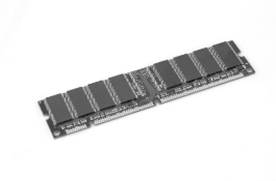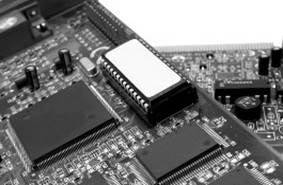Exercise 9. Translate the following text in a written form. Use a dictionary if necessary
The central processing unit is the part of a computer which controls all the other parts. The CPU generally consists of the control unit, the arithmetic and logic unit (ALU), registers, temporary buffers and various other logics.
The control unit selects and retrieves instructions from memory and decodes them to produce signals which control the other parts of the computer. These signals cause it to transfer data between memory and ALU or to activate peripherals to perform input or output.
Various types of memory, including cache, RAM and ROM, are often considered to be part of the CPU, particularly in modern microprocessors where a single integrated circuit may contain one or more processors as well as any or all of the above types of memory.
(http://encyclopedia2.thefreedictionary.com/Main+processor)
Units of memory
Remember the following words and word combinations.
1. temporary – временный
2. permanent – постоянный
3. retain, v – сохранять, удерживать
4. install, v – устанавливать
5. depend upon, v – зависеть от
6. specifications – технические характеристики
7. primary – главный, основной
8. punching device – устройство перфорации
9. hard disc drive – жесткий диск
10. flash drive – флеш-накопитель, флешка
11. divide, v – делить
12. responsible - ответственный
13. promptly – быстро
14. access, v – получить доступ
15. erase ,v – стирать (из памяти)
16. randomly – случайно, наугад
17. load, v - грузить, нагружать
18. include, v – включать
19. related - имеющий отношение
20. certain - определенный
21. lose (lost, lost), v – терять, не сохранять
22. stick (stuck, stuck), v – оставаться надолго, зд. внедряться
23. alter, v – изменять, видоизменять
24. irrespective – не зависящий (от чего – л.)
Read and translate the text.
Text 2
Units of memory
Computer memory is a physical electronic device that is used to store data and applications on a temporary or a permanent basis. It enables a person to retain the information stored on the computer. There are various types of computer memory that can be installed, depending upon the actual need for functioning and specifications of the system.
Computer memory can be classified into two types: Primary Memory (or Main Memory) and Secondary Memory.
· Primary Memory can be divided into two types - Random Access Memory (RAM) and Read Only Memory (ROM).
· Secondary Memory: Punching Devices, Magnetic Tape, Floppy Disk, Optical Discs (CD/DVD), Hard Disk Drives, and Flash Drives


RAM ROM
RAM is a memory scheme within the computer system responsible for storing data on a temporary basis, so that it can be promptly accessed by the processor as and when needed. Data will be erased when the storage device is turned off. RAM stores data randomly and the processor accesses these data randomly from the RAM storage. The information stored in the RAM is typically loaded from the computer's hard disk, and includes data related to the operating system and certain applications. When the system is switched off, the RAM loses all stored information. The data remains stored on secondary storage though, and can be retained when the system is running again. Most modern computers use an embedded RAM circuitry on the motherboard which reads data in bursts. So, modern RAM devices are not random memory devices as such; they are burst memory access devices, but the term RAM has stuck in everyday usage.
There are primarily two forms of RAM: Static RAM (SRAM) and Dynamic RAM (DRAM).
Unlike RAM, ROM is a permanent form of storage. ROM stays active regardless of whether power supply to it is turned on or off. The ROM memory used in modern computers is pre-programmed by the circuit manufacturer and cannot be altered by the user.
Secondary memory is available on mass storage devices for permanent data storage. Data stored on a secondary device is retained even when it is not supplied any power. This data can be transported in most cases, and looks and appears the same on any machine, irrespective of where the data was first copied onto the secondary storage device.
